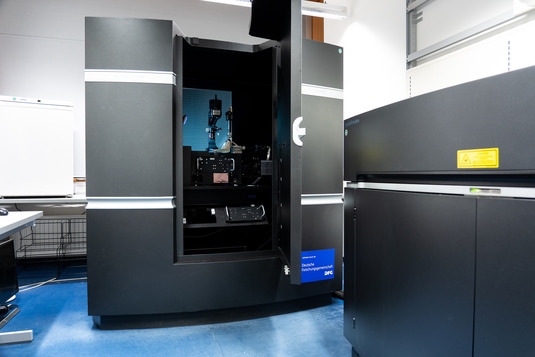Structured illumination
Technique
Structured illumination was the first super resolution technique available. The resolution increase can be illustrated with the so called Moiré effect. If two gratings are superimposed, one can detect a pattern that has a lower frequency than each of the superimposed gratings (Moiré fringes). If the frequencies of one grating and the structure visible after superposition are known, one can backcalculate the frequency of the other grating. In light microsocpy, a 3D illumination structure of known frequency is superimposed to the specimen containing unknown frequencies. From the frequencies in the resulting images, one can backcalculate the frequencies in the specimen. By using this technique, one can increase the resolution of a light microscope by a factor of about two.
Use
Ideal for imaging volumes (e.g. whole nuclei) at high resolution. The techniqe generates super-resolved 3D images - 2D measurements are not possible. For technical reasons, many images have to to be aquired in order to reconstruct the complete object information. Therefore, the method works best on fixed samples that are stained according special protocols. It is hard to extract quantitative information from the images, as they are the result of complex mathematical resonstructions.
Configuration
Manufacturer:
General Electric
Type: OMX
Illumination:
Lasers: 405nm, 488nm, 593nm; Halogen (DIC)
Optics:
100x 1.4 oil immersion objective UPlanSApo (Olympus)
Cameras:
Photometrics Cascade II cameras, 512x512 pixel
max. field of view 40x40µm (512x512 pixel)
Image stacksize max. 40 x 40 x 15 µm, dz=0.125 µm
Filters:
442/46 (405)
525/50 (488)
615/24 (593)
629/53 (593)
685/40
Speed:
Time needed for acquisition approx. 2-5 minutes / stack, depending on the size of the stack (number of sections, colors, pixels)
Time needed for the reconstruction of super-resolution images from the already acquired stack: 1-10 minutes, depending on the size of the stack (number of sections, colors, pixels etc.). The reconstruction has to be done with the post-processing computer next to the OMX with SoftWorx software
Software:
Acquisition: DeltaVisionOMX Vers. 2.25.
Reconstruction: SoftWorx Vers. 5.1.0


